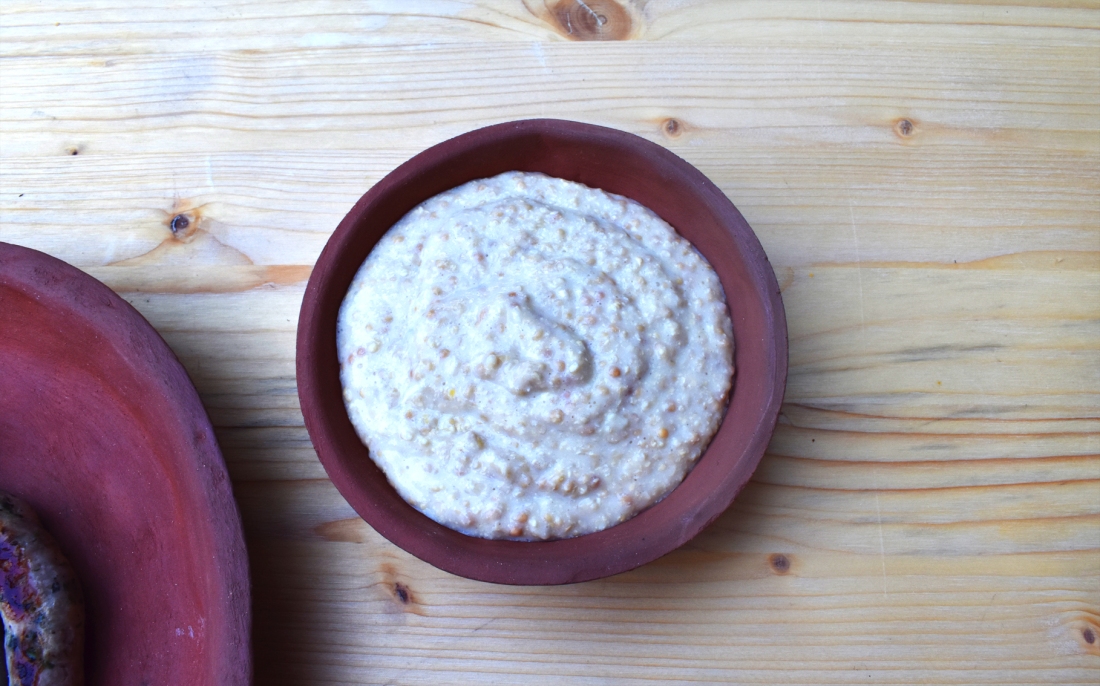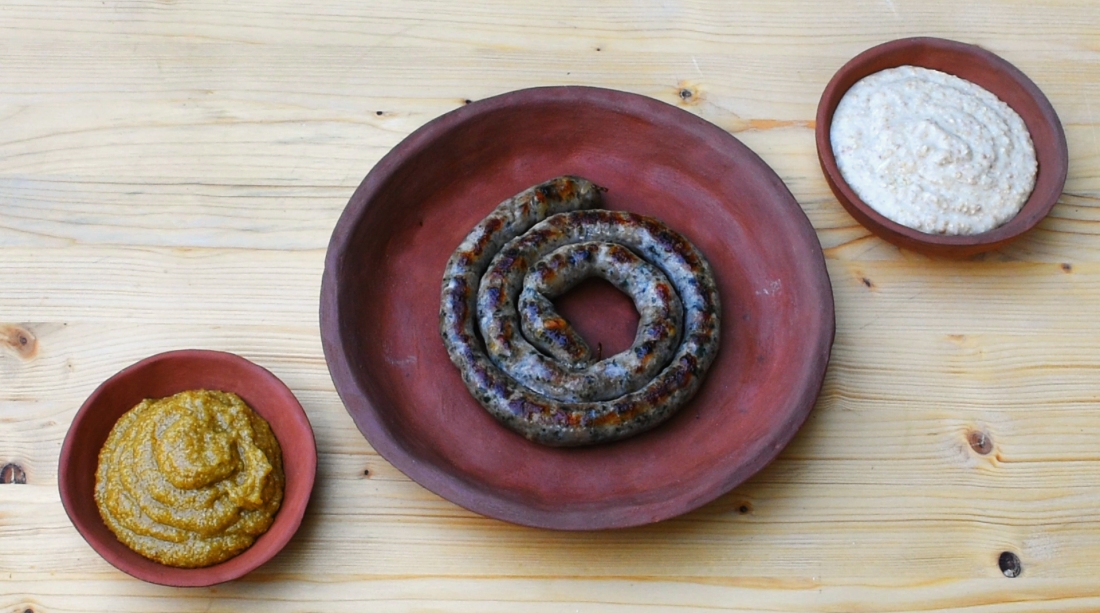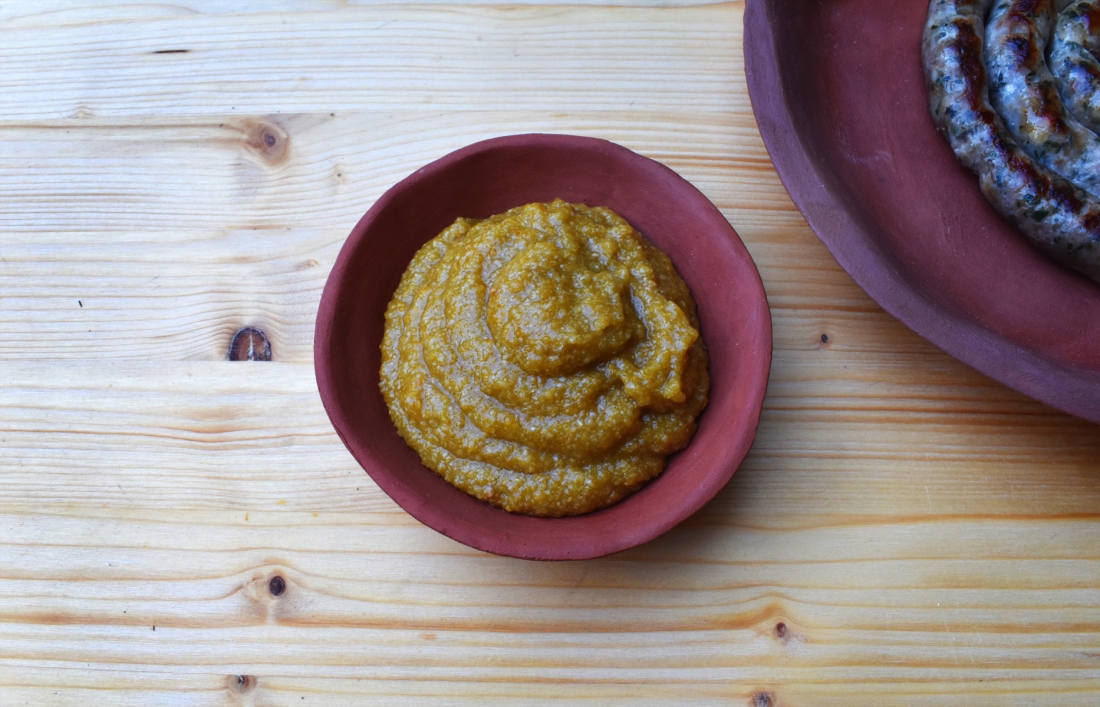Mustard was one of the most common sauces in ancient Rome. Used also alone, it appears as an ingredient for more complex recipes in the cookbook attributed to Marcus Gavius Apicius, De Re Coquinaria, who doesn’t give us his own method. We chose using the recipes of Palladius and Columella, quite different but both interesting, to prepare the mustards we served with the lucanica, an ancient Roman smoked sausage.
Almost four centuries separate the two authors, a testimony of the popularity of this sauce that, throught the centuries, is widely used still today. Columella (1st century) and Palladius (4th century), both agronomists, are fundamental sources not only for the agriculture and farming, but also for the many recipes of preserves, sauces, alcoholic beverages, cheese, honey, oil they wrote in their treatises. Differently from Apicius, who writes recipes for rich banquets, Columella and Palladius’ methods are simpler and meant also for farmers and common people.
Below, you will find a note about the ingredients and the original recipes with the translation into English.
You can pair this mustards not only with smoked sausages, but also with other meat dishes such as guinea fowl or roast chicken. Enjoy!
COLUMELLA’S RECIPE
The author suggests two versions of this recipe: one, simpler, without pine nuts and starch for the common meals; the second, which we are preparing here, meant for banquets.
Columella uses saltpeter, a quite common ingredient for preserves well known by ancient Romans. For the dilution in water, we suggest following the directions on the label.
Ingredients
white mustard seeds
wheat starch
pine nuts
saltpeter
white wine vinegar
Method
Soak the mustard seeds in water for a couple of hours, then grind them in the mortar. Flatten the mustard paste, then make a few holes with your fingers for placing inside hot charcoals. Pour the saltpeter diluted in water, discard the water, and remove the charcoals. Now, you can add the pine nuts and the starch, grinding anything together to reach a smooth consistency. Put the sauce on the fire. When it is thickened, the mustard is ready.
The original text
Semen sinapis diligenter purgato et cribrato; deinde aqua frigida eluito et, cum fuerit bene lotum, duabus horis in aqua sinito; postea tollito, et manibus expressum in mortarium novum aut bene emundatum adicito et pistillis conterito. Cum contritum fuerit, totam intritam ad medium mortarium contrahito et comprimito manu plana; deinde cum compresseris, scarifato, et, inpositis paucis carbonibus vivis, aquam nitratam suffundito, ut omnem amaritudinem eius et pallorem exsaniet. Deinde statim mortarium erigito, ut omnis umor eliquetur. Post hoc album acre acetum adicito et pistillo permisceto colatoque. Hoc ius ad rapa condienda optime facit. Ceterum, si velis ad usum conviviorum praeparare, cum exsaniaveris sinape, nucleos pineos quam recentissimos et amylum adicito diligenterque conterito, infuso aceto. Cetera, ut supra dixi, facito. Hoc sinapi ad embamma non solum idoneo sed etiam specioso uteris; nam est candoris eximii, si sit curiose factum.
Translation
Clean and sift diligently the mustard seeds, then wash them with cool water and, when it is well washed, soak them in water for two hours. After taking them off, squeeze the seeds with you hands and put them in the mortar, new or well cleaned, and grind with the pestle. When they are ground, gather the paste in the middle of the mortar and flatten it with your opened hand; then make holes and place inside hot charcoals. Pour water with saltpeter to remove the bitterness and the yellow color from the mustard. Lift the mortar to pour off the water. Add white, strong vinegar, mix with the pestle, and strain it. This is an excellent sauce for the turnips.
To prepare the sauce for the banquets, after having cleaned out the mustard, add well-ground, fresh pine nuts and starch, pouring vinegar. The other steps are the same as above. This kind of mustard not only is useful for the sauces, but it is also beautiful: if well made, it is colored with a fine white.
PALLADIUS’ RECIPE
This is a recipe for a sweet mustard. We changed a bit the ratio of the ingredients, and we suggest doing the same according to your taste.
Ingredients
white mustard seeds
honey
extra virgin olive oil
white wine vinegar
Method
Grind the mustard seeds in the mortar, then add white wine vinegar, honey, and olive oil. Mix well everything and serve.
The original text
Senapis semen ad modam sextarii unius et semis redigere curabis in puluerem, cui mellis pondo quinque, olei hispani unam libram, aceti acris unum sextarium miscebis et tritis omnibus diligenter uteris.
Translation
Grind one sextarium of mustard seeds with five pounds of honey and one of Hispanic oil, diluting with one sextarium of strong vinegar. Grind diligently everything together and use.
Recipes
Ancient Roman Sausage VIDEO
Ancient Roman Chicken VIDEO
Ancient Roman Barley Polenta VIDEO
Ancient Roman Farmer’s Meal – Flatbread and Moretum VIDEO
Ancient Roman Poached Eggs VIDEO
Ancient Roman Stew VIDEO
Ancient Roman Sea Bass VIDEO
Ancient Roman Stuffed Dates VIDEO
Ancient Roman Mussels VIDEO
Ancient Roman Taro VIDEO
Ancient Roman Guinea Fowl VIDEO
Ancient Roman Fava Beans VIDEO



